Monitoring is essential in live performance as it enables musicians to hear their instruments, vocals, and other band members with clarity. This allows performers to maintain proper pitch, rhythm, and overall cohesiveness during a performance.
This article compares two popular monitoring solutions: in-ear monitors (IEMs) and floor monitors (wedges). We will delve into the advantages and disadvantages of each option to help you make an informed decision for your live sound setup.
Our aim is to provide a comprehensive comparison of in-ear monitors and floor monitors, covering their pros and cons and discussing factors to consider when choosing the right solution for your live performance. Let’s get started.
In-Ear Monitors (IEMs)
Overview and functionality
In-ear monitors (IEMs) are a monitoring solution designed to provide a personalized audio experience for musicians and performers during live shows.
They consist of small earphones that fit snugly inside the ear canal, creating a seal that isolates external noise and delivers a customized audio mix directly to the performer. This enables musicians to focus on their performance without being distracted by ambient sounds or the venue’s acoustics.
IEMs often use wireless technology to transmit the audio signal from a mixing console to a receiver unit worn by the performer. This receiver then sends the audio signal to the in-ear monitors. Wireless systems provide the advantage of freedom of movement on stage, as performers are not tethered by cables.
The audio mix for IEMs is usually created by a monitor engineer, who is responsible for adjusting the levels of each instrument and vocal input to match the preferences of each musician. This gives performers a personalized mix highlighting the elements they need to hear most clearly during a performance.
In-ear monitors can be customized to fit the unique shape of each performer’s ear, providing optimal comfort and sound isolation. Custom-molded IEMs are created using impressions of the individual’s ear canal, resulting in a perfect fit and improved noise isolation. Alternatively, universal-fit IEMs come with various interchangeable ear tips to accommodate different ear shapes and sizes.
Overall, IEMs offer a high level of audio control, sound quality, and consistency that can significantly enhance a performer’s experience on stage. By isolating external noise and delivering a tailored audio mix, in-ear monitors allow musicians to focus on their performance and achieve better results.
Next, we present a few examples of in-ear monitors that deliver excellent results for live performance. The last one on this list is an inexpensive option that’s perfect for church praise teams:
- Xvive U4 Wireless in-Ear Monitor System
- Shure PSM300 Wireless in-Ear Monitoring System
- Sennheiser IEM G4-Twin-A1 in Ear Monitor System
- XTUGA RW2080 Rocket Audio
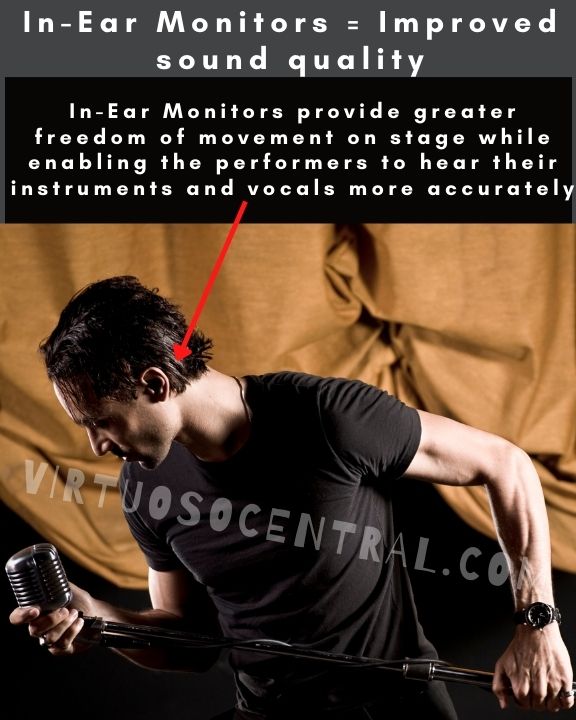
Pros of In-Ear Monitors
1. Improved sound quality and consistency
IEMs deliver superior sound quality with greater detail and consistency compared to floor monitors, thanks to their direct audio delivery method.
This enables performers to hear their instruments and vocals more accurately, ensuring better intonation and timing.
In addition, IEMs are less prone to the interference of external noise and room acoustics, which contributes to a more precise and reliable listening experience.
2. Personalized mix control
With IEMs, each musician can have a tailored mix, allowing them to focus on the instruments or vocals they need to hear most clearly.
This level of personalization enables better overall performance by allowing musicians to emphasize or de-emphasize specific sound sources according to their needs.
3. Reduced stage volume and feedback
IEMs help lower stage volume, as they don’t require loudspeaker monitors to project sound toward the performers.
As a result, the risk of microphone feedback is reduced, leading to cleaner sound quality and fewer distractions for both the performers and the audience.
4. Enhanced mobility and comfort
IEMs provide greater freedom of movement on stage, as performers aren’t limited by the position of floor monitors. They are also lightweight and less obtrusive than over-ear headphones, allowing for more comfortable and dynamic performances.
Cons of In-Ear Monitors
1. Initial investment and maintenance costs
IEMs tend to have a higher upfront cost than floor monitors, particularly when opting for high-quality systems with custom-molded earpieces.
Ongoing expenses, such as replacement ear tips, batteries, and wireless system maintenance, should also be considered when evaluating the overall cost-effectiveness of IEMs.
2. Potential for isolation from audience and bandmates
The noise isolation provided by IEMs can create a sense of detachment from the audience, potentially making it more challenging to gauge audience reactions and establish a connection during a performance.
Furthermore, IEMs can hinder communication with fellow band members, as they may reduce the ability to hear cues or spontaneous interactions.
3. Reliance on batteries and wireless technology
IEMs often depend on battery-powered wireless systems, which can be vulnerable to interference, signal dropouts, or battery failure during a performance.
To minimize these risks, it’s essential to invest in reliable wireless systems and ensure that batteries are regularly checked and replaced as needed.
4. Ear fatigue and hearing protection considerations
Extended use of IEMs at high volumes can lead to ear fatigue and potential hearing damage. It’s important to monitor volume levels and take breaks to protect your hearing.
Custom-molded earpieces can help alleviate pressure points and provide a more comfortable fit, reducing the risk of ear fatigue.
Additionally, using ambient microphones or vented ear tips can help maintain a better balance between sound isolation and awareness of the surrounding environment.
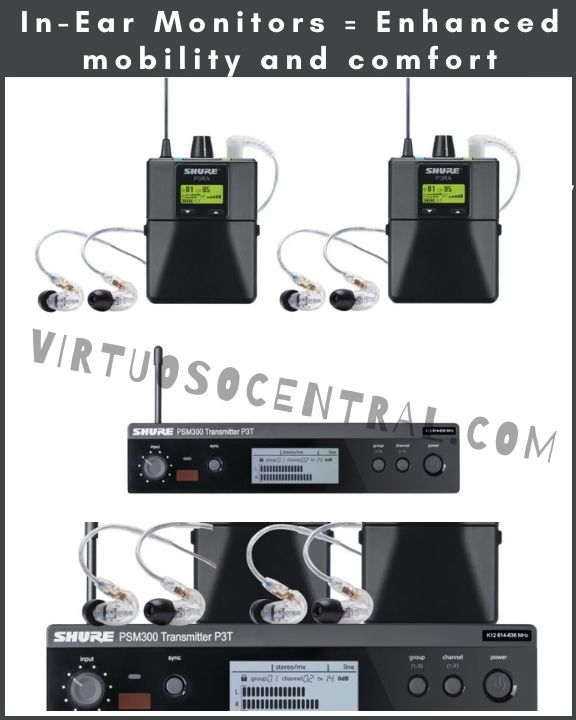
Floor Monitors (Wedges)
Overview and functionality
Floor monitors, also known as stage monitors or wedges, are speaker cabinets specifically designed for live performances. They are typically placed on the stage floor, angled upwards towards the performers, ensuring that the audio is directed at the musicians rather than the audience.
Floor monitors provide musicians with a clear and balanced mix of instruments and vocals, allowing them to hear themselves and their bandmates during a performance.
The audio mix for floor monitors is created by a monitor engineer or sound technician, who adjusts the levels of each instrument and vocal input based on the performers’ preferences. This mix is separate from the front-of-house mix, which is tailored to the audience’s listening experience.
The monitor mix, when using wedges, can be either a single mix shared by all band members or individual mixes for each performer, depending on the complexity of the performance and the available equipment.
Floor monitors come in various sizes and configurations, including passive and active designs. Passive monitors require an external power amplifier to drive the speakers, while active monitors have built-in amplifiers, simplifying the setup process.
The choice between passive and active floor monitors largely depends on the specific requirements of the performance, the available budget, and the preferences of the sound engineer and musicians. Here is an article explaining how to set up stage monitors; click the link to check it out.
Floor monitors are a vital tool for live performers, delivering a mix of instruments and vocals that enables musicians to stay in sync with their bandmates and maintain a high-quality performance.
Their familiarity, ease of use, and versatility make them a popular choice for a wide range of live performance scenarios.
Here are a few examples of powered (active) floor monitors from a wide range of prices, delivering excellent results and used extensively in the industry by professional sound engineers:
- JBL Professional Portable 2-Way Self-Powered Monitor
- Electro-Voice Coaxial Monitor
- Samson 2-Way Active Stage Monitor
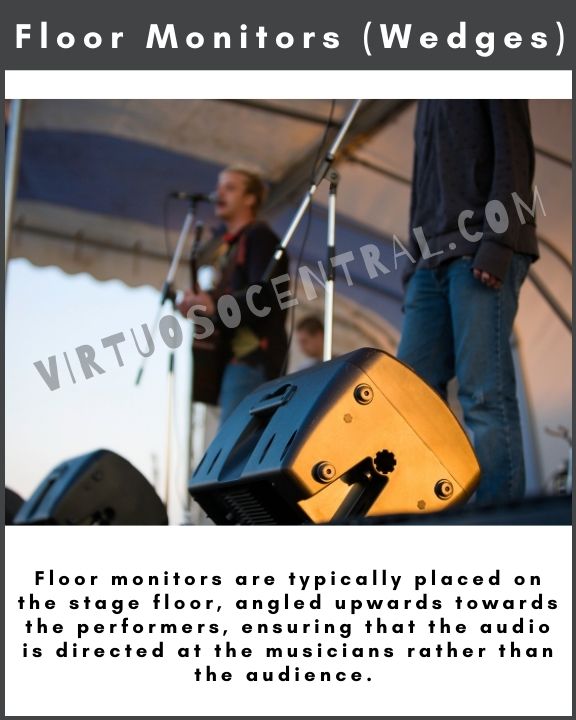
Pros of Floor Monitors
1. Familiarity and ease of use
Floor monitors have been a staple in live performances for decades, making them a familiar and comfortable choice for many musicians.
Their simple setup and ease of use during performances allow musicians to focus on their performance without worrying about complex monitoring systems.
2. Lower upfront cost
Compared to IEMs, floor monitors generally come with a lower initial cost, making them a more budget-friendly option for some performers, particularly those just starting or on a tight budget.
3. Shared monitoring experience among band members
Unlike IEMs, which provide individualized mixes, floor monitors enable a shared monitoring experience. This allows performers to hear the same mix, fostering better communication and cohesion among band members on stage.
4. No reliance on batteries or wireless technology
Floor monitors are typically hardwired to the mixing console, eliminating the need for batteries or wireless systems. This removes the risk of battery failure or signal interference during a performance, ensuring a more stable and reliable monitoring experience.
Cons of Floor Monitors
1. Limited sound quality and consistency
Floor monitors might not deliver the same level of sound quality and consistency as IEMs, making it more challenging for musicians to hear their instruments and vocals clearly.
The sound quality from floor monitors can also be affected by the acoustics of the venue and the position of the monitors on stage.
2. Increased stage volume and potential for feedback
Using floor monitors contributes to higher stage volume, as the sound from the monitors can bleed into the audience and other microphones on stage.
This increases the risk of feedback issues, which can be disruptive and challenging to manage during a performance.
Dealing with feedback issues is not easy, but there are ways to minimize it and achieve loud volumes while avoiding feedback. Here is an article that explains how to stop feedback on stage.
3. Restricted mobility and stage clutter
Floor monitors can limit a performer’s mobility on stage, as they must remain within the monitor’s coverage area to hear their mix clearly.
In addition, floor monitors can contribute to stage clutter, which can be a challenge in tight spaces and make it more difficult for performers to move around freely.
4. Difficulty in achieving the perfect mix for each performer
Creating an ideal mix for each musician can be challenging with floor monitors, especially when sharing the same audio source.
This makes it challenging to cater to individual preferences, and performers may struggle to hear specific instruments or vocals clearly, potentially affecting the overall performance quality.
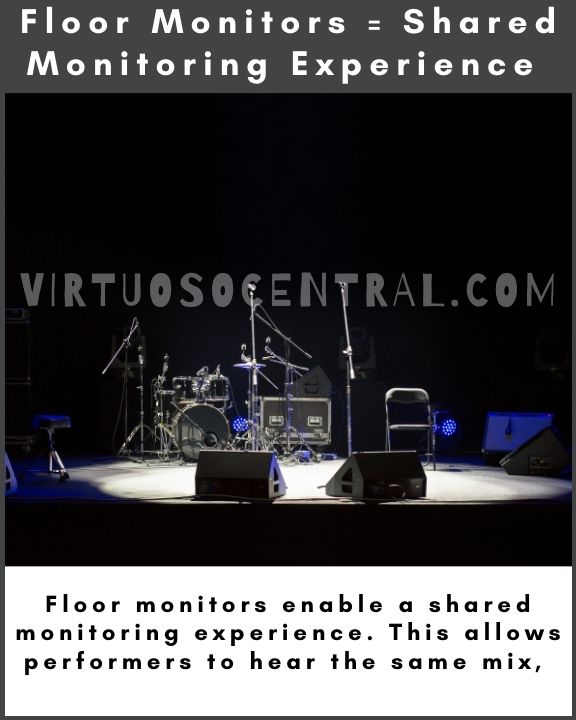
Factors to Consider When Choosing a Monitoring Solution
1. Budget and cost-effectiveness
When selecting a monitoring solution, it’s essential to consider your available budget and weigh the cost-effectiveness of each option.
Consider not only the upfront costs but also the ongoing maintenance and replacement expenses associated with each solution.
While IEMs might have a higher initial cost, they could offer long-term benefits regarding sound quality and performance enhancement.
2. Performance environment and venue size
The size and acoustics of your performance venue can significantly impact the effectiveness of your chosen monitoring solution. IEMs are generally better suited for larger venues or those with challenging acoustics, as they provide a more consistent and personalized listening experience.
On the other hand, floor monitors may be sufficient for smaller venues where sound reinforcement and isolation are less critical.
3. Musical genre and onstage dynamics
The style of music you perform and the dynamics of your stage presence may also influence your choice of monitoring solution.
IEMs can offer better mobility for performers who engage in choreography or move around the stage frequently, as they aren’t limited by the position of floor monitors.
Conversely, floor monitors may be more suitable for bands with a stationary setup or those who prefer a more traditional, shared monitoring experience.
4. Performer preferences and adaptability
Lastly, consider the preferences and adaptability of the musicians involved in your performance. Some performers may prefer one monitoring solution over the other based on past experiences or personal comfort.
In addition, each musician’s adaptability, as switching from one monitoring solution to another may require a period of adjustment.
It’s essential to find a monitoring solution that best suits the needs of your performers to ensure the best possible live performance experience.
Hybrid Monitoring Solutions
Combining In-Ear Monitors and Floor Monitors for Flexibility
A hybrid approach to monitoring combines the use of both in-ear monitors (IEMs) and floor monitors (wedges) to create a more flexible monitoring environment.
This setup allows performers to choose the monitoring solution that best suits their individual needs while still maintaining a shared monitoring experience for those who prefer it.
For instance, a lead vocalist might opt for IEMs to have better control over their mix, while other band members use floor monitors for a more communal listening experience.
Benefits And Challenges of Implementing a Hybrid System
Implementing a hybrid monitoring system can offer the best of both worlds, providing the advantages of both IEMs and floor monitors. Some of the benefits include:
- Greater flexibility: A hybrid system allows each performer to choose the monitoring solution that best meets their needs and preferences, improving overall comfort and performance quality.
- Enhanced sound control: Combining IEMs and floor monitors allows for better control over stage volume, as some performers can reduce their reliance on loud floor monitors.
- Adaptability: A hybrid setup can cater to various performance situations and accommodate different performers’ needs, making it a versatile option for touring bands or multi-act events.
However, implementing a hybrid system also presents some challenges. Here are a few to take into consideration:
- Increased setup time and expense: A hybrid system may require additional equipment, such as wireless transmitters for IEMs and extra floor monitors, increasing the overall cost and setup time.
- Complex mixing process: Managing a combination of IEM and floor monitor mixes can be more complicated for the sound engineer, as they must balance individual and group monitoring needs.
- Potential for phase and feedback issues: Using IEMs and floor monitors can increase the risk of phase and feedback problems, requiring careful attention to monitor placement and mix levels.
When considering a hybrid monitoring solution, weigh the benefits against the challenges to determine if it’s the right choice for your performance needs.
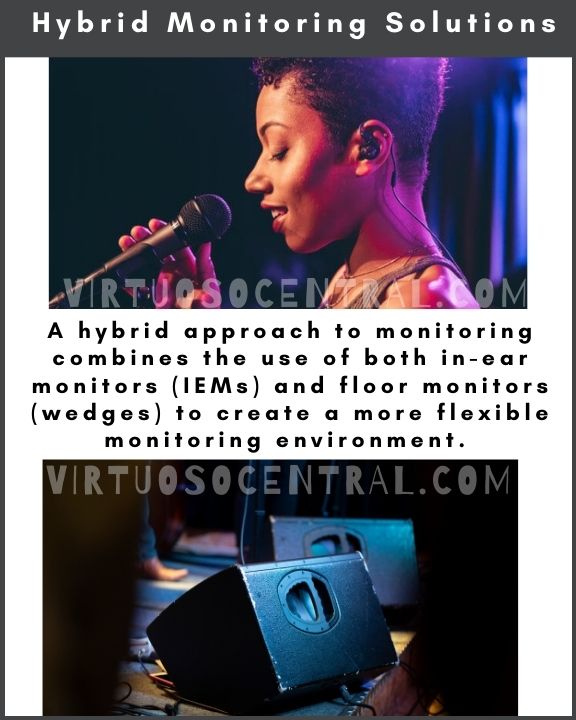
Tips for Making the Most of Your Monitoring System
Ensuring Proper Fit and Comfort for In-Ear Monitors
To maximize the benefits of in-ear monitors (IEMs), ensuring a proper fit and comfort is essential. Choosing the right ear tips is crucial for sound quality, noise isolation, and overall comfort.
Experiment with different sizes and materials to find the best ear fit. Alternatively, consider investing in custom-molded earpieces that are tailored to your unique ear shape, providing optimal comfort and sound quality.
Optimizing Floor Monitor Placement and Angling
For floor monitor users, strategic placement and angling can significantly improve sound quality and minimize feedback issues. Place monitors at an angle that directs sound toward the performers’ ears while avoiding microphone pickup patterns to reduce the risk of feedback.
Experiment with different positions and angles to find the sweet spot that provides the best monitoring experience without causing unwanted noise issues.
Communicating With Sound Engineers and Band Members
Effective communication with sound engineers and fellow musicians is key to achieving the best monitoring experience, regardless of the solution you choose. Be clear about your monitoring preferences and any specific requirements you have for your mix.
Regularly discuss your monitoring needs with your sound engineer and band members to ensure everyone is on the same page and can work together to optimize the monitoring setup.
Regularly Assessing and Updating Your Monitoring Setup
Evaluate your monitoring setup regularly and make necessary adjustments to adapt to changing performance needs and environments.
Whether it’s altering the mix levels, repositioning floor monitors, or replacing worn-out ear tips, regular assessment and maintenance can help you maintain a high-quality monitoring experience.
Additionally, stay informed about new technologies and developments in the world of live sound monitoring to ensure you’re always using the most effective solutions for your performances.
Conclusion
In-ear monitors and floor monitors each have their own set of advantages and drawbacks. IEMs generally offer superior sound quality and mobility, while floor monitors provide a familiar and shared monitoring experience.
Choosing the right monitoring solution is crucial for ensuring optimal performance quality and a positive experience for both musicians and audiences.
When deciding between in-ear and floor monitors, carefully weigh the pros and cons while considering personal preferences, venue size, musical genre, and budget. Considering these aspects, you can make a well-informed decision that best suits your live performance needs.
If you liked this article, consider sharing it with others, and don’t forget to visit our website to explore more articles like this one by clicking here. Thank you for reading my blog.